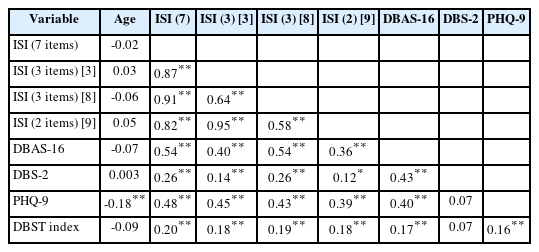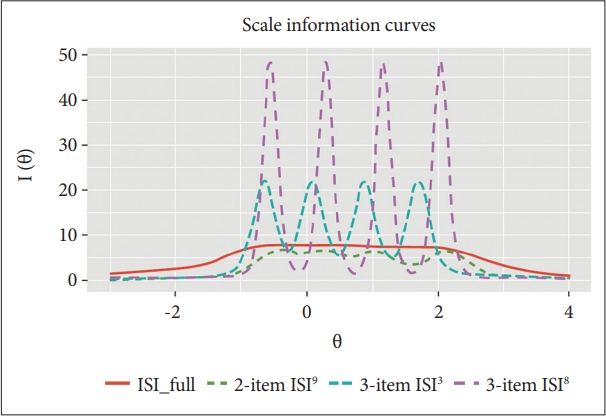Psychometric Properties of the Insomnia Severity Index and Its Comparison With the Shortened Versions Among the General Population
Article information
Abstract
Objective
The aim of this study was to explore the psychometric properties of the Insomnia Severity Index (ISI) based on modern test theory, such as item response theory (IRT) and Rasch analysis, with shortened versions of the ISI among the general population.
Methods
We conducted two studies to evaluate the reliability and validity of the shortened versions of the ISI in a Korean population. In Study I, conducted via online survey, we performed an exploratory factor analysis (n=400). In Study II, confirmatory factor analysis (CFA) was conducted (n=400). IRT and Rasch analysis were performed on all samples. Participants symptoms were rated using the ISI, Dysfunctional Beliefs and Attitudes about Sleep–16 items, Dysfunctional Beliefs about Sleep–2 items, Patient Health Questionnaire–9 items, and discrepancy between desired time in bed and desired total sleep time.
Results
CFA showed a good fit for the 2-factor model of the ISI (comparative fit index=0.994, Tucker–Lewis index=0.990, root-meansquare-error of approximation=0.039, and standardized root-mean-square residual=0.046). The 3-item versions also showed a good fit for the model. All scales showed good internal consistency reliability. The scale information curve of the 2-item scale was similar to that of the full-scale ISI. The Rasch analysis outputs suggested a good model fit.
Conclusion
The shortened 2-factor ISI is a reliable and valid model for assessing the severity of insomnia in the Korean population. The results are needed to be explored further among the clinical sample of insomnia.
INTRODUCTION
Insomnia is a common complaint in psychiatric primary care clinics [1]. It has been consistently reported that women are predisposed to insomnia, and insomnia has become more prevalent among the older population as time has progressed [2]. The Insomnia Severity Index (ISI) [3] is commonly used both in clinical practice and in research to measure the severity of insomnia. The ISI is a brief scale that is reliable and well-validated in numerous languages. There are seven items in the questionnaire that are designed to assess sleep onset (item 1a), sleep maintenance (item 1b), early morning awakening (item 1c), satisfaction with sleep patterns (item 2), interference with daily functioning due to sleep problems (item 3), other people’s perceptions of the impairment caused by sleep disorders (item 4), and worry regarding sleep problems (item 5).
The ISI has been reported to be a 2-factor model. Moscou-Jackson et al. [4] reported a 2-factor structure with seven items (Factor I: item 1a, 1b, and 1c; Factor II: item 2, 3, 4, and 5), and Otte et al. [5] reported a slightly modified version of the same scale (Factor I: item 1a, 1b, 1c, and 2; Factor II: item 3, 4, and 5) (Table 1) [3-9]. Although the complete ISI scale is a brief Likerttype scale that can be applied in clinical practice, several studies have examined a shortened version of the ISI that can be used in clinical practice. Morin et al. [3] validated the ISI and proposed that the first three items (item 1a, 1b, and 1c, indicating the severity of initial, middle, and late insomnia, respectively) can possibly be used together as a shortened version of the ISI. Wells et al. [8] explored the shortened version of the ISI, and they observed that three items (item 2–“satisfaction,” item 3–“interference,” and item 5–“distress”) together could be used as a reliable and valid brief version of the ISI. Furthermore, using two items (item 2–“satisfaction” and item 3–“interference”), Kraepelien et al. [9] proposed a very brief version of the ISI.
In the Korean population, the ISI has already been validated in a study of 169 patients with primary insomnia, 133 patients with comorbid insomnia, and 312 patients with obstructive sleep apnea [10]. The Korean version of the ISI is a reliable (Cronbach’s α=0.92) and valid (Pittsburgh Sleep Quality Index and polysomnography) rating scale. In terms of brief versions of the ISI, Park and Lee [11] explored factors of the ISI together with the Epworth Sleepiness Scale (ESS) among shiftworkers; however, they reported the ISI as a single-factor model. Lee et al. [12] also attempted to explore the simplification of the ISI together with the ESS using machine learning models, and they proposed a positive brief version using items 1a, 1b, 3, and 5 of the ISI, and two items of the ESS. However, the reliability and validity of the shortened versions of the ISI have not been examined in the Korean population.
It is true that the ISI is already a brief rating scale that can be easily applied to clinical practice. However, shortened versions of the ISI are also necessary in the case of national surveys or digital therapeutic applications requiring various rating scales to evaluate various symptoms. On the other hand, previous study on the validation of the Korean version of the ISI showed the convergent validity of the ISI, but it did not show the construct validity. Here, we aimed to explore the psychometric properties of the ISI scale based on modern test theory, such as item response theory (IRT) and Rasch analysis, in the general population. Furthermore, we compared the psychometric properties of the full-version of the ISI with the shortened versions (the two 3-item and one 2-item versions) of the ISI.
METHODS
Participants and procedure
Here, we analyzed 800 samples from two studies conducted among the general population in Korea. The protocol of this study was approved by the Institutional Review Board (IRB) of Asan Medical Center (2023-0686).
Study I
This study was conducted as an anonymous online survey via a survey platform of the professional survey company, EMBRAIN (Seoul, Korea; www.embrain.com) from September 26–30, 2022 [13]. The survey was conducted to explore the association between insomnia severity and discrepancy between desired time in bed and desired total sleep time (DBST) index. Among the general population in Korea participants responded to the survey questions as well as demographic information, including the participants’ age, sex, and marital status, were collected. In addition, participants were asked whether they had a history of psychiatric illness or were currently experiencing symptoms of insomnia. Based on the Central Limit Theorem, sample size was estimated using 50 samples allocated to 8 cells (divided into four groups each by biological sex and age). Our goal was to collect data from 400 participants enrolled in the survey system, from a total of 1,640,000 registered general population panels. Emails were sent to 7,195 panels, 1,021 accessed the survey, and 460 responses were collected. The survey company delivered the first 400 responses after excluding identifiable information, incomplete responses, and responses with a fast response speed. The protocol of this study was approved by the IRB of Asan Medical Center (2022-1283), and the requirement for obtaining informed consent was waived.
Study II
We conducted a confirmatory factor analysis (CFA) for the ISI using samples collected from the general population of Korea between January 10 and 18, 2022 [14], to explore the association between dysfunctional beliefs about sleep and bedtime and total sleep time among the general population. All 400 panels registered in an online survey system of the professional survey company (EMBRAIN) responded to the survey which included questions on participant demographics (including age, sex, marital status, psychiatric history, and current psychiatric distress). Based on the Central Limit Theorem, the sample size was estimated using 40 samples allocated to 10 cells (divided into five groups by biological sex). As in Study I, we aimed to collect data from 400 participants enrolled in the survey system, from a total of 1,640,000 registered general population panels. Emails were sent to approximately 3,000 panels, 949 accessed the survey, and 436 responses were collected. The company delivered the first 400 responses after removing identifiable information, incomplete responses, and responses with a fast response speed. The IRB of the Asan Medical Center (2021-1755) approved the survey study and waived the requirement for obtaining written informed consent.
Measures
ISI
The ISI is a 7-item ordinal rating scale that assesses an individual’s perceived severity of insomnia [3]. All seven items in the ISI can be rated on a 5-point Likert scale. A higher total score indicates a greater severity of insomnia. The Korean version of the ISI was applied in this study [10].
Dysfunctional Beliefs and Attitudes about Sleep–16 items
The Dysfunctional Beliefs and Attitudes about Sleep–16 items (DBAS-16) is a 16-item self-rating scale that assesses an individual’s dysfunctional beliefs about sleep [15]. Originally all 16 items are rated on 100-mm visual analog scales [15]; however, we asked participants to rate all items on a 11-point Likerttype scale ranging from 0 (strongly disagree) to 10 (strongly agree). The final score was calculated by dividing the total summed score across all the 16-items by 16. Here, we applied the Korean version of the DBAS-16 scale. The Cronbach’s α for this sample was 0.903.
Dysfunctional Beliefs about Sleep–2 items
The Dysfunctional Beliefs about Sleep–2 items (DBS-2) is an ultra-brief rating scale that can measure an individual’s dysfunctional beliefs about sleep [16]. It consists of two items that can be rated on a scale ranging from 0 (strongly disagree) to 10 (strongly agree). A higher total score indicates a higher level of dysfunctional beliefs about sleep. Here, we applied the original version of the scale which was developed in Korean. The split-half coefficient for this sample was 0.864.
Patient Health Questionnaire–9 items
The Patient Health Questionnaire–9 items (PHQ-9) is a selfadministered rating scale that assesses an individual’s severity of depression [17]. It consists of nine items that can be rated on a 4-point Likert scale from 0 (not at all) to 3 (nearly every day). A higher total score indicates a severe degree of depression. Here, we applied the Korean version of the PHQ-9 [18]. The Cronbach’s α for this sample was 0.890.
DBST index
The DBST index is defined as a discrepancy between the desired time in bed (TIB) and desired total sleep time (TST) in individuals who suffer from insomnia [19]. We previously reported that the DBST index is correlated with insomnia severity [19]. The DBST index was calculated based on responses to the questions, “From what time to what time do you want to sleep? (desired TIB),” and “For how many hours do you want to sleep in a day? (desired TST),” as [desired hours of TIB]-[desired hours of TST].
Statistical analysis
We used IBM SPSS version 21.0 (IBM Corp., Armonk, NY, USA), JASP version 0.14.1.0 (JASP Team, Amsterdam, The Netherlands), and RStudio (Posit, Boston, MA, USA) to conduct the statistical analysis.
In step one, we conducted an exploratory factor analysis (EFA) on the dataset from Study I. Normality was assumed based on the skewness and kurtosis of all seven items of the ISI ranging within ±2 [20], and the adequacy of the sampling and suitability of the data was assessed using the Kaiser–Meyer– Olkin (KMO) value and the significance of the Bartlett’s test of sphericity. A parallel analysis was performed to estimate the number of factors. Next, an EFA was conducted using the maximum likelihood method in conjunction with Pearson’s correlation matrix for oblimin rotation.
In step two, we conducted a CFA on the dataset from Study II. Normality was assumed based on the skewness and kurtosis of all seven items of the ISI ranging within ±2 [17]. CFA with a diagonally weighted least squares estimator was run to confirm the explored factor structure of the dataset from Study I. In addition, we explored the model fits for two 3-item versions of the ISI [3,8]. A satisfactory model fit was defined by a standardized root-mean-square residual (SRMR) value ≤0.05, root-mean-square-error of approximation (RMSEA) value ≤0.10, and comparative fit index (CFI) and Tucker–Lewis index (TLI) values ≥0.90 [21,22]. Multi-group CFA analysis was performed to examine whether there was measurement invariance in ISI across sex (male vs. female) and groups varying in depression status (PHQ-9 score <10 vs. PHQ-9 score ≥10). The convergent validity of the ISI was examined using preexisting rating scales, such as DBAS-16, DBS-2, and PHQ-9, using Pearson’s correlation coefficients.
In step three, the psychometric properties of the ISI were assessed using the Study I dataset. We ran a graded response model (an IRT model for polytomous items including slopes, difficulties, item characteristic curves, scale information curves, and IRT reliability) and Rasch analysis (infit mean square [MnSq], outfit MnSq, item difficulties, item and person reliabilities, and separation indices) to estimate the psychometric properties of the scales.
RESULTS
Factor analysis
The demographic characteristics of the participants in Study I (n=400) are presented in Supplementary Table 1 (in the online-only Data Supplement). The item-level properties are presented in Table 2. All items were distributed based on skewness ranging from -0.207 to 0.503 and kurtosis ranging from -0.867 to -0.427. Sampling was adequate, and data were suitable for factor analysis (KMO=0.800, Bartlett test of sphericity with p<0.001). The EFA results showed that the fullscale ISI was clustered into two factors: Factor I, items 1a, 1b, 1c, 2, and 5; Factor II, items 3 and 4. Factor loadings ranged from 0.637 to 0.880 and 0.621 to 0.974 for Factors I and II, respectively.
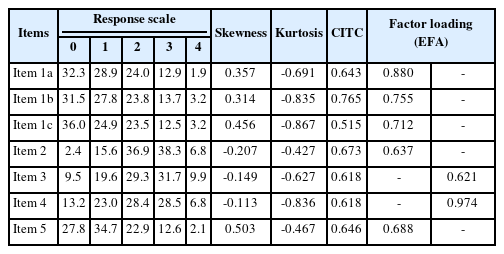
Item properties of the Insomnia Severity Index among participants in Study I and factor loading values of the exploratory factor analysis (EFA)
We conducted a CFA using the Study II dataset. The demographic characteristics and symptom rating scale scores are presented in Supplementary Table 2 (in the online-only Data Supplement). All items were distributed based on skewness and kurtosis ranging from -0.326 to 0.546 and -0.900 to -0.263, respectively (Table 3). The CFA results showed that the data were a good fit for the 2-factor model of the ISI (CFI=0.994, TLI=0.990, RMSEA=0.039, and SRMR=0.046) (Table 4), with factor loadings ranging from 0.627 to 0.988 and 0.761 to 0.993 for Factors I and II, respectively. The results of multigroup CFA showed that the ISI can measure insomnia severity with strong invariance across groups regardless of sex and depression status (Supplementary Table 3 in the online-only Data Supplement). The 3-item ISI proposed by Morin et al. [3] also showed a good model fit (CFI=1.000, TLI=1.000, RMSEA=0.000, and SRMR=0.000), with factor loadings ranging from 0.660 to 0.978. However, the factor loadings of the 3-item ISI proposed by Wells et al. [8] ranged from 0.330 to 1.024, showing that this shortened version cannot be applied to the Korean sample. The 2-item ISI7 could not be explored using CFA (Table 3).
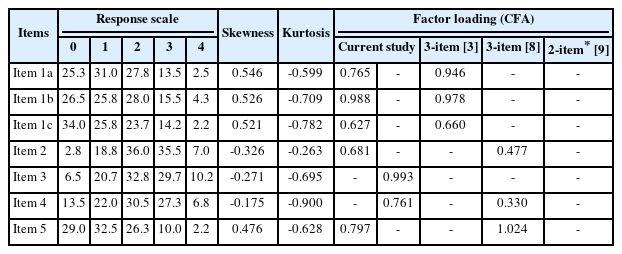
Item properties of the Insomnia Severity Index among participants in Study II and factor loading values of the confirmatory factor analysis (CFA)
Reliability of the ISI scales based on relations to other variables
The internal consistency reliability of the full-scale ISI (Cronbach’s α=0.799) (Table 4), 3-item ISI by Morin et al. [3] (Cronbach’s α=0.748), 3-item ISI by Wells et al. [8] (Cronbach’s α=0.569), and 2-item ISI [9] (Split-half coefficient=0.699) were good. All items on the full scale had an acceptable corrected item-total correlation, ranging from 0.515 to 0.765. The full-scale ISI, the two 3-item scales, and the 2-item scale were moderate to highly correlated with each other (Table 5). All ISI scales were significantly correlated with other rating scales such as the DBAS-16, DBS-2, and PHQ-9 (all p<0.01). Additionally, the DBST index was significantly correlated with all ISI scales (all p<0.01).
Graded response model and Rasch analysis
The graded response model (IRT model) outputs of the full-scale ISI are presented in Supplementary Table 4 (in the online-only Data Supplement). The fit values of all items in Factor I were nonsignificant, and the nonsignificant model fit suggests that these items belong to Factor I of the ISI. Regarding the slope parameter (α), item 1c had a moderate slope, and the other items had a very high slope (Supplementary Table 4 in the online-only Data Supplement and Figure 1) [23]. Item 1c provided the least information, and item 4 provided the most information. Of the two items in Factor II, item 4 had a very high slope (Supplementary Table 4 in the online-only Data Supplement). In Factor I, the threshold coefficient suggested that a higher latent trait or theta was required to endorse all items except for item 2. In Factor II, a higher latent trait or theta was required to endorse the response options “much” to “very much noticeable/worried” in both items. Figure 2 shows that the 2-item scale has a scale information curve similar to that of the full-scale ISI. However, the two 3-item ISI scales showed several ups and downs in the curves. This is because one item on each scale had a very high slope (above 10). Item characteristic curves in Figure 1 visually present this information. The ISI had good IRT reliability (0.868). Supplementary Table 5 (in the online-only Data Supplement) shows the Rasch analysis outputs, such as the infit and outfit MnSqs. Both infit and outfit MnSqs ranged between 0.78–1.49 and 0.76–1.47, respectively, suggesting a good model fit. In Factor I, item 2 was the least difficult item (-1.30) and item 5 was the most difficult item (0.48). In Factor II, item 3 was the least difficult and item 4 was more difficult. Both factors have acceptable item and person reliability and an item separation index. Factor I, but not Factor II, had an acceptable person separation index. This is because Factor II contained only two items.
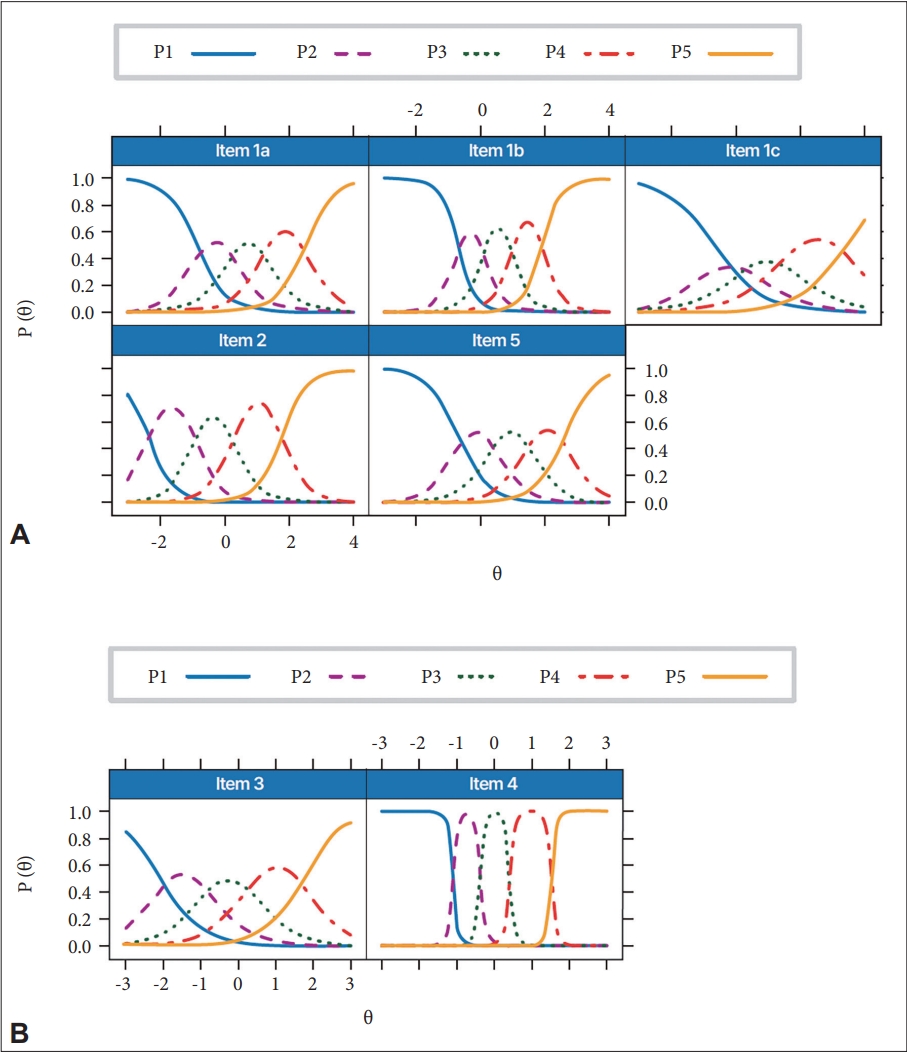
Item characteristic curve. Item characteristic curves show the parameters of discrimination and difficulty of the Factor I (A) and Factor II (B) of the 2-factor model of the Insomnia Severity Index. Theta (θ) represents the latent trait being measured by the tests.
DISCUSSION
Here, we observed that the 2-factor model of the Korean version of ISI is a reliable and valid rating scale for assessing insomnia. It showed good internal consistency reliability and convergent validity with other rating scales that can measure depression, dysfunctional beliefs about sleep, or discrepancy between desired TIB and desired TST. The 3-item ISI scales proposed by Morin et al. [3] and Wells et al. [8] showed a good fit for the model in the CFA; however, the 3-item ISI proposed by Wells et al. [8] was not consistent based on factor loading values. The 2-item ISI proposed by Kraepelien et al. [9] showed good internal consistency reliability.
We evaluated a 2-factor model of the ISI; however, the structure was different from that in previous studies [4,5]. Items 1a, 1b, and 1c are core indicator items of the ISI [24]. However, these items assess different forms of insomnia [9]. These three items alone were not considered a comprehensive criterion for insomnia because an individual can suffer from initiation problems but not maintenance problems [24]. Therefore, other items may be needed to cover the differences. We observed that item 2 (“satisfaction”) and item 5 (“worry”) were clustered together with items 1a, 1b, and 1c as a separate factor. In a study performed to validate the Spanish version of the ISI [25], a 3-factor solution was proposed, and item 2 was clustered into a separate single-item factor. According to previous studies that reported a factor that included items 1a, 1b, 1c, and 2, item 2 can be clustered together with items 1a, 1b, and 1c [5,7]. However, we also observed that item 5 was not clustered together with items 3 and 4. This result is not consistent with previous studies on ISI validation [5,7]. The first three items, 1a, 1b, and 1c, and two other items (item 2–“satisfaction” and item 5–“worry”) in Factor I can be considered as items inquiring about specific insomnia symptoms and their related subjective symptoms; however, item 3 (“function”) and item 4 (“noticeable”) in Factor II are relatively objective symptoms. As we observed that items 3 and 4 were clustered into a separate factor, the 3-item ISI proposed by Wells et al. [8] was not a good fit for this sample. However, the 3-item ISI proposed by Morin et al. [3] showed a good fit to the data in this sample. Though CFA is not available on the 2-item scale of the ISI [9], it showed good internal consistency reliability. Based on the scale information curve (Figure 2), the curve of the 2-item scale was similar to that of the full-scale ISI. However, the two 3-item ISIs showed several ups and downs in the curves for both the versions. Item 4 had a very high slope (above 10), which may have influenced the scale of the 3-item ISI proposed by Wells et al. [8] Moreover, Likert-type response options also play a role in these ups and downs.
There were some limitations to this study. First, we need to consider that the difference in psychometric properties among various versions of the ISI may come from the different language versions or different study populations. Second, this study was conducted via an anonymous online survey rather than a face-to-face clinical interview. It is possible that the questionnaire was misunderstood, resulting in bias in the factor structure of the ISI. Third, the study was conducted in the general population rather than a clinical sample of patients with insomnia. Thus, we could not confirm whether the participants had insomnia. Last, this study was conducted during the coronavirus disease-2019 pandemic, which collectively caused people to suffer from sleep disturbances as a result of being quarantined or isolated. Therefore, the results of this study should be interpreted with caution.
In conclusion, we observed that the 2-factor ISI model is a reliable and valid rating scale. Two 3-item ISI scales also showed a good fit for the CFA model. All the shortened versions showed good internal consistency reliability. This is the first report to compare the full-scale and shortened versions of the ISI among the Korean population. The ISI can be used by researchers and clinicians to assess and quantify insomnia symptoms with greater confidence. In addition, detailed analyses enhance understanding of individual items, latent traits, and the overall structure of the scale. Using the results of this study, we can choose useful versions of the ISI, depending on the objectives.
Supplementary Materials
The online-only Data Supplement is available with this article at https://doi.org/10.30773/pi.2023.0189.
Demographic characteristics of participants in Study I
Demographic characteristics of participants in Study II
Measurement invariance across sex, depression, and insomnia
Outputs from the graded response model
Outputs from the Rasch analysis
Notes
Availability of Data and Material
The datasets generated or analyzed during the study are available from the corresponding author on reasonable request.
Conflicts of Interest
Seockhoon Chung and Yoo Hyun Um, a contributing editor of the Psychiatry Investigation, were not involved in the editorial evaluation or decision to publish this article. All remaining authors have declared no conflicts of interest.
Author Contributions
Conceptualization: all authors. Data curation: Seockhoon Chung. Formal analysis: Seockhoon Chung, Oli Ahmed, Hong Jun Jeon. Funding acquisition: Seockhoon Chung. Methodology: all authors. Project administration: Seockhoon Chung. Validation: Seockhoon Chung, Oli Ahmed, Hong Jun Jeon. Writing—original draft: all authors. Writing—review & editing: all authors.
Funding Statement
None



